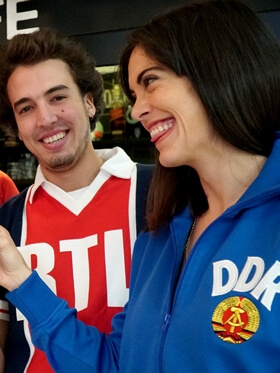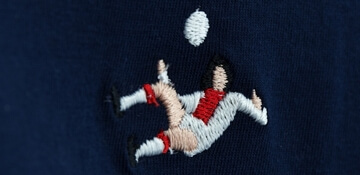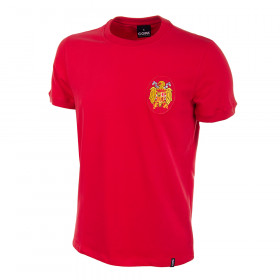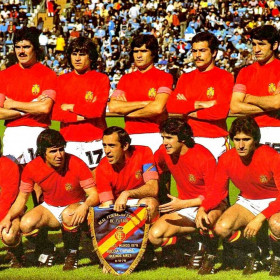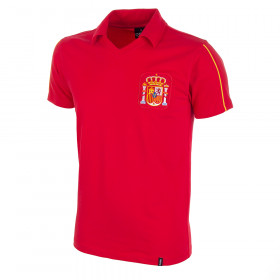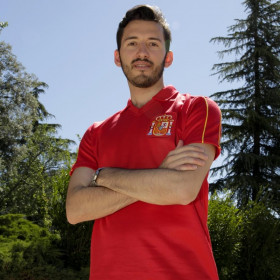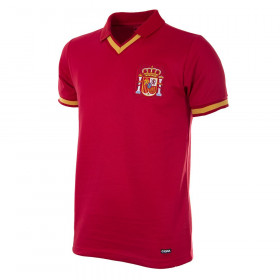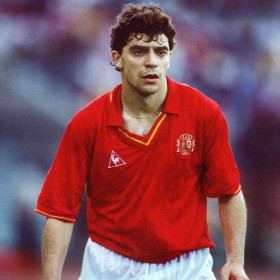Spain Retro Shirts

-
Spain 1978 retro shirt
£55.39 -
Spain 1980's Retro Shirt
£55.39 -
Spain 1988 Retro Shirt
£55.39
Spain Retro Shirts
Our Retro Footballshirt collection of the Spanish national team shows a trip through the seventies, eighties and nineties of one of the best national teams in the 21st century. Beside other you find the following classics:
The Spain 80s Retro Shirt: In this era la Roja began to prepare a team that was able to fulfill the hopes of their supporters. The team managed to qualify for the three big tournaments in this decade, the World Cup 1982 in Spain, the European Championship 1984 in France, at which Spain managed to beat West Germany and went on to the final against France; and the World Cup 1986 in Mexico. Legendary players like Juanito, Zamora and Santillana were part of the squad, that showed a potential that their successor fulfilled decades later in full expression.
Spain 1990 Retro Shirt: A remarkable Retro-Poloshirt of the Spanish national team of the 90s, which was guided at the world cup 1990 in Italy by Quinta del Buitre, a generation of Spanish footballers. Famous personalities, that shaped an era in Spanish football; Butragueño, Miguel Pardeza, Manolo Sanchís, Míchel González and Rafael Martín Vázquez.
The football of the Spanish team earns a special spot in the history of world football, even if the events in the last century were not always pleasing for the supporters. The spectacular wins of La Roja in the 21st century have their justification, also because of the experience that was gained before. Do not miss our beautiful and colourful Shirts of the Spanish national team.
History and shirts of Spain football team
The history of the Spanish national team is an interesting journey through several twists a of turns of fate.
In 1920 the Spanish national football team with coach Francisco Bru played their first match against Denmark. The Spanish won 1-0, the first goal was scored by Patricio Arabolaza. The Spanish team, also known as La Roja, The Red, has a very high reputation among international football fans. La Roja's retro shirts are increasingly appreciated and demanded, a proof that they keep imprinted on them the nostalgia of this epic football team. They are the symbol of the the Spanish team victory in the 2010 World Cup in South Africa and in three European championships; in 1964, 2008 and 2012.
History and shirts of the Spanish football Team - 1920s
The 100-year-old pioneers won the silver medal at the Olympic Games that were held in the Belgian city of Antwerp . For this occasion, players such as Ricardo Zamoe, Jose Samitier, Jose Maria Belauste, Ramón Eguizábal, Félix Sesúmaga and Artola, Francisco Pagazaurtundua, wore a red shirt with a rampant lion - symbol of Belgium but also featured on the shield of the spanish King Alfonso XIII - on the right side, the side of the heart and with a V-neck with laces in the purest style of the 20s.
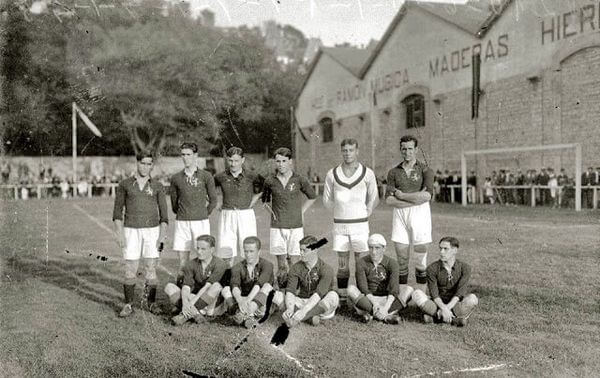
In the following Olympic Games in Paris in 1924 the Spanish runner-up did not manage to reach the final round, he was eliminated by Italy, a team that will become his eternal rival of those years, with a sad own goal. Even so, in this 1924 Olympic Games, the Spanish national football team will wear a bright and daring shirt for the time; a Red polo neck shirt with a large red V for victory on the front and back. In addition, the shield will change and the initials of the Spanish Football Federation will be included in an inverted triangle, with a crown at the upper base of the triangle.
In the 1928 Olympic Games in Amsterdam the Spanish team finished with the same result as in the 1924, the squad which was respected by its rivals, had to return home eliminated by Italy in the quarterfinals. It should be noted that Italy was among the favorites. The final of this Olympiad was perfect: Argentina agains Uruguay, this last took the victory.
As we have indicated above, in this first decade the shirt and the shields are changing. The Spanish away shirt will be white and will follow the design of the first kit and there will also be a third kit in light blue. Here is a mythical photo of the Spanish soccer team from the 1920s.
History and jerseys of the Spanish soccer team - 1930s
The Spanish team did not participate in the first football World Cup that was held in 1930 in Uruguay. Some national teams of Europe thus showed their anger with FIFA for not having held this first World Cup in the home of football, England, as they wanted, despite the fact that the Uruguayan Federation offered to pay the trip to all the participants teams.
In the 1934 World Cup that was played this time in Europe, specifically in Italy, the Spanish team beat the Brazilian team in the round of 16 by 3-1 with a penalty saved by Zamora, the spanish famous idol goalkeeper, to a penalty shot by the legendary Brazilian player Leonidas. This stop is inscribed in football history for being the first save of for a penalty in a World Cup. Many spanish old fans still remember a saying from their childhood when playing football, "1-0 y Zamora de porter" "1-0 and Zamora as a goalkeeper!"
However, in the end Spain fell again against Italy in a kind of all out war by the Italian players; seven Spanish players and four Italians were injured. In addition there was a highly controversial arbitration decisions in favor of the Italian team.
Due to the Civil War, Spain could not participate in the 1938 World Cup that was held in France. And later due to the conflict of World War II international football competitions were canceled or minimized.
With the arrival of the Spanish Republic of 1931, the crown of the previous crest with the initials of the Spanish Football Federation in an inverted triangle or circle was removed. This crest will be used in the matches played in this period of the Spanish Republic until the end of the Civil War in 1939. It should be noted that the crest from 1934 acquired the colors of the Second Republic; Red, yellow and dark purple. The shirts will be red with a V-neck polo and white laces or for the 1934 World Cup they will be red button-down polo shirts.
History and jerseys of the Spanish soccer team - 1940s
In the 1940s, the Spanish football national team played several friendly matches with Portugal, the first in 1942 but also played friendlies with the teams of France and of Italy. We can see images of the team with dark blue shirts, white V-neck and the coat of arms of Franco's Spain; the eagle of Saint John in black and the symbols of the Falange such as the yoke and arrows. From 1942, the V-neck sported the colors of the Spanish flag, such colors will disappeared in 1945. At the end of the 1940s, the Spanish shirt will once again be an elegant shirt, with a shirt collar, and buttoned all the way down. The second kit will be white.
History and jerseys of the Spanish football team - 1950s
The 1950s began in a dazzling way for the Spanish team when they were semi-finalists in the 1950 World Cup in Brazil, finally finishing in fourth place in the table. Led by Guillermo Eizaguirre, they beat the United States, Chile, and the English team in the first phase with the mythical goal by Zarra and the no less famous broadcast of Matias Prats singing the goal on the radio. The semifinals were played in the form of a league where Spain could not win their rivals; against Uruguay the match ended with an honorable draw at 2 goals but against Brazil they lost 6 to 1 and against Sweden they fell 3 to 1.
We found players of the stature of Telmo Zarra, a specialist in header shots, who scored 4 goals, Estanislao Basora scoring 3 goals or defender José Parra.
This World Cup ended with the defeat of Brazil against Uruguay in what is known as the Maracanazo.
In 1950 the Spanish players wore a red polo jerseys with three buttons that went down to the middle of the shirt. The crest will be the Saint John's eagle in gold color and for the first time the shirts will show the large number of the players in white on the back.
These good beginnings were not repeated throughout the decade of the 1950s; Spain could not participate in the 1950 World Cup in Switzerland because they did not qualify, nor could they qualify for the 1958 World Cup in Sweden, which was a great disappointment for the fans of the Red Fury of the 50s.
History and kits of the Spanish soccer team - 1960s
Before this decade and later with the joy's from 2000, La Roja's trophy cabinet contained only one trophy, the 1964 UEFA European Championship, whose final phase was played in Spain. The spanish won that championship in June 1964, under the leadership of the great José Villalonga, after defeating at the Santiago Bernabéu stadium 2-1 the USSR where the fearsome goalkeeper Lev Yashin played in the final .
It was also the second time the European Championship was played.
To get to this last match, the team had to beat Hungary in the semifinal in an abrupt and difficult match for the Spanish; This match was decided in overtime with Amancio's goal, for a final score of 2-1.
In the final match, great players such as Luis Suárez, Marcelino, Pereda, who scored the goals, Amancio, Calleja, Ignacio Zoco had used the second blue shirt of the Spanish team to distinguish themselves from the red of the Soviet Union.
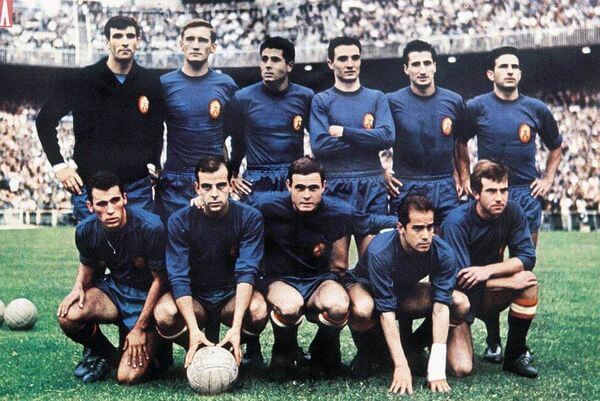
We can say that it was a blow of fate since the red shirt so characteristic of the Spanish team did not change for almost 20 years, from 1960 to 1979. Red round collar shirt, long sleeves and the Saint John's eagle crest on the side of the heart.
In the 1962 and 1966 World Cups with the Hispanic-Hungarian Ferenc Puskás, the Spanish team did not achieve its objectives and was left out of the final phases. That of 1966 in which the hopes of the Red fans had been placed after the 1964 triumph was very sad.
History and jerseys of the Spanish football team - 70's
The 70's were shadowy years. The Spanish team did not qualify for the World Cups in Mexico in 1970 or Germany in 1974.
We highlight the participation in the World Cup in Argentina in 1978. The Spanish team was led by Ladislao Kubala and great players were part of the team; Asensi, Pirri or strikers Dani , Rexach or Quini and del Bosque who was injured.
Spain played in the group of Brazil, Sweden and Austria. In the first game against Austria, the squad began his journey with a 2-1 defeat after Dani's goal. Brazil was not at its best since the team was in low hours, but it had great flashes with players like Zico and Rivelino; the match ended in a draw. The victory against Sweden with an Asensi goal did not allow the team to continue.
The shirt will also be the classic red polo shirt. You can see the replica above, Spain 1978 Shirt, in the shirts section. No other detail to highlight except that Franco had died in 1975 but the democratic Spanish Constitution of December 1978 had not yet been voted, so in full transition the Franco coat of arms continued to be used.
History and shirts of the Spanish football Team - 1980s
From the 1980s we can highlight the 1982 World Cup in Spain. After Kubala's poor results in previous years - he spent 11 years as coach - José Emilio Santamaría took over the reins. The club on which he based the new national squad was the Real Sociedad from which players such as Arconada, López Ufarte, Zamora, Periko Alonso and Satrústegui came. Spain had to play in Group E along with Yugoslavia, Northern Ireland and Honduras, it seemed an easy group in principle. The first game showed the harsh reality to the excited Spanish fans; tie to 1 against Honduras. The difficult victory against a tough Yugoslavia by 2-1 did not venture better prospects. The defeat against Northern Ireland led to the team to have to face the difficult first group with Germany and England.
The German team with a victory by 2-1 definitively unseated the Red from the illusion of repeating the feat of the 1964 Euro.
It was at the 1982 World Cup in Spain when the biggest change in the team's equipment took place; the constitutional crest appeared for the first time. In addition, from 1981 the Adidas brand became the sponsor and the kit supplier of the team. The Adidas logo appeared on the opposite side of the shield. The shirt is modernized, with a V-neck polo, short sleeves and three gold stripes on the shoulders.
Later from 1984 Le Coq Sportif would be the chosen brand and would include its rooster logo. The jersey had modifications on the previous basis. Fundamentally, the shoulder bands characteristic of the Adidas brand from the 80s were withdrawn.
In 1986 Spain played one of the best world championships of the recent era. Under the direction of Miguel Muñoz, the Spanish team played a first phase in which they showed themselves as a very competitive team capable of facing a great Brazil with Michel's phantom goal and two victories against Northern Ireland and Algeria. In the round of 16, the team played one of the revelations of the tournament, Laudrup and Larsen's Denmark. In a brilliant match, the Spanish team easily beat Denmark by 5 goals to 1 with 4 goals from Emilio Butragueño. In the quarterfinals it was time to face Belgium that had been playing well. Spain was superior, especially in the second half and in extra time, but the "fateful" penalty shootout was reached. All the kickers of both teams were marking until it was the turn of the Asturian Eloy who failed his kick. This match prevented Spain from crossing the great Diego Armando Maradona's Argentina in the semifinals. Here is a photo of that mythical Spanish team from the 86 World Cup:
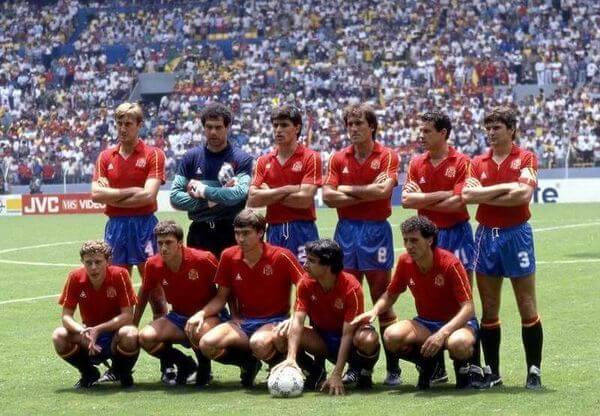
Above you can visit the Spain 1980's Retro Shirt, elegant and with the crest of the constitutional flag.
History and jerseys of the Spanish football team - 1990's
With the Quinta del Buitre, the experienced group of players that was coming to an end the early '90s seem to bring good cheer to the fans.
In the 1990 World Cup in Italy, Spain lost 1-2 in the decisive match against Yugoslavia with a goal from Salinas. Dragan Stojkovic scored 2 goals, the second thanks to Michel who removed his head and Stojkovic sentenced the match. Here we name some players who were in the World Cup; Martín Vázquez, Butragueño, Zubizarreta, Sanchís, Fernando Hierro among others.
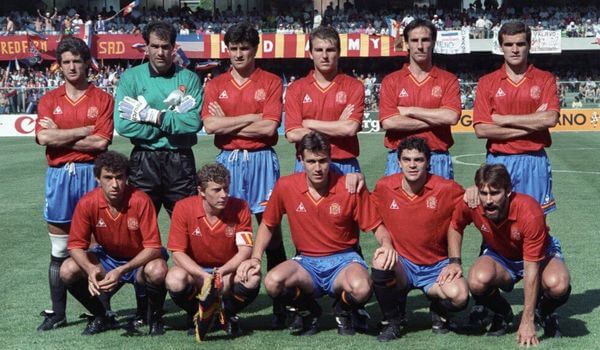
Spain took the gold in the 1992 Olympic Games in Barcelona, which brought renewed enthusiasm to the national team. It was the first great title of the modern era. Luis Enrique, Kiko and Cañizares defeated Poland in the final by 3-2.
In the shirt section above you can see the replica Spain 1988 Retro Shirt from the years 88 to 90.
https://www.retrofootball.co.uk/football-shirts/spain-1988-retro-shirt.html
An elegant polo shirt with a gold V-neck marking the flag of Spain as well as on the short sleeves.
In the 1994 World Cup in the United States the team fell on the the gates of the semifinals. It was one of the best performances by La Roja. Players to highlight; Guardiola, Cañizares, Luis Enrique, Lopetegui, Fernando Hierro, a generation of players turned into coaches today. The spanish reds team finished in eighth position.
The 1998 World Cup in France marked the end of a stage; When they fell in the first round, it was the beginning of the end for Clemente as a coach who had led the team through a the World Cup in the USA 94 and a European Championship in England 96. There were were improving and had great hopes for the World Cup in France.
History and kits of the Spain soccer team - From 2000s
Spain has considerably enriched its rankings since the 2000s. Forty-four years later the Spanish national team won its second UEFA European Championship against the Germans with the goal of the mythical El Niño Torres to in a vibrant final.
From then on, everything is rolled! Their extraordinary epic continues in South Africa in 2010, where La Roja claimed their first world title against the Dutch, a final that ended 1-0 after 120 minutes of play and a lot of tension. Andrés Iniesta's goal in the 116th minute is already part of the Spanish football imagination.
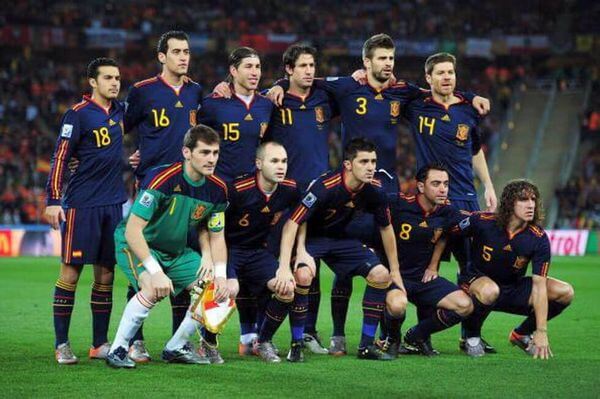
The Spaniards, always eager for feats, continue their great odyssey, and this time it was during Euro 2012 when they won against Italy after a final that ended with a resounding victory of 4-0, a great revenge of the first decades where Italians always sent Spaniards home in international championships. Fabulous players like Iniesta, Xavi, Fabregas and many others who had the opportunity to wear this shirt were the architects of this great epic.
Thanks to this victory, "The Red one" becomes the first European national team that has chained the triumphs in the European Championship, the World Cup and again the European Championship.
It goes without saying that the historic jerseys of the Spanish team have become highly sought.
Adidas has been the most important brand of The Red one. The brand with the three stripes was the designer of an impressive number of retro shirts. Outstanding players such as Iker Casillas, Carles Puyol, Raùl and many other stars have had the honor of wearing these vintage shirts and have contributed to enrich the history of La Roja a little more with each game.
All these players who have worn these retro jerseys have made history in Spanish football. Lovers of the Spanish team will remember the skill of their idols. Our Retro shirts will allow you to remember these exciting and intense moments. If you want to buy these vintage jerseys that pay tribute to a great football country, feel free to visit our online store. We offer you the opportunity to enrich your collection with a historical shirt that will make you vibrate with passion, as if you were attending a final of the European Championship or the World Cup. You just have to place your order and you will be fully satisfied.
 Retrofootball
Retrofootball  Belgium
Belgium  France
France  Germany
Germany  Italy
Italy  Portugal
Portugal  Spain
Spain  Switzerland
Switzerland  United Kingdom
United Kingdom  other countries
other countries  Retrorugby
Retrorugby 
